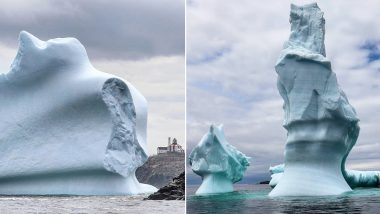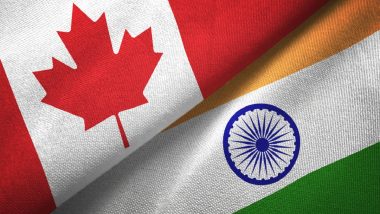Stunning photos of giant icebergs passing by Canada's Cape Bonavista were captured by a photographer Mark Gray recently. The images clicked from his home in Cape Bonavista, Newfoundland show 'iceberg alley' drifting by in the Labrador Sea. While the gigantic icebergs look gorgeous, it also shows the terrible effects of global warming leading to melting. One of the pictures where the iceberg is captured next to the Cape's iconic lighthouse gives us an idea of how huge is the floating chunks of ice. 40 Years of Icebergs Breaking Off in Antarctica Captured in a 50-Second Clip (Watch Video)
Sharing the photo on Twitter, he wrote, "Our Cape Bonavista Lighthouse looks pretty small in comparison to this huge iceberg!" He gives names to the berg depending on how they look. From ice-cream to salad bowls you can spot them all in Gray's photos. He dubbed one of the icebergs as 'The Lurker' as it floated behind a rocky piece of land. Tweeting the picture he wrote, "Best iceberg season in Bonavista in years!" American Grandmother Posing on Iceberg Tossed by The Wind to Sea; Her 'Misadventure' Pictures Go Viral.
Here are the pictures:
Our Cape Bonavista Lighthouse looks pretty small in comparison to this huge iceberg! #iceberg #bonavista #explorenl #photography #cbcnl pic.twitter.com/b6iZOTFLAg
— Mark Gray (@MarkGray3) May 18, 2019
The 'Alley stretches from the coast of Labrador to the southeast coast of Newfoundland. Tourists from far and wide come to the place to catch a glimpse of the giant natural beauties. Every year, 400 to 800 icebergs float to the coast of Newfoundland. In 1984, a record of 2,000 icebergs was spotted from the province of Canada.
The Best of All!
One of my favorite shots from yesterday's boating excursion.
Had to wait for the splash through the iceberg. #iceberg #bonavista #explorenl #photography pic.twitter.com/3Qm7i4PqLB
— Mark Gray (@MarkGray3) May 19, 2019
The icebergs consist of 10,000 to 12,000-year-old-ice in them and mostly come from glaciers in western Greenland. They are generally 150 feet above the water and come in various shapes and sizes. According to Newfoundland's official tourism page, locals use the water from the fresh water glacier to make cocktails including gin or vodka of which 'iceberg beer' is the most popular one.
Oh-so-huge Ice-cream!
Would you like a small or large ice cream cone? LOL #bonavista #iceberg #nature #ShareYourWeather pic.twitter.com/7Q1QizhQhW
— Mark Gray (@MarkGray3) May 19, 2019
Giant salad bowl!
Today, a very big iceberg broke apart at Cape Bonavista. One portion now looks like a salad bowl to me. LOL
It's super windy and cold down there tonight, but that didn't stop me, or the tourists! #bonavista #iceberg #ShareYourWeather #explorenl pic.twitter.com/ZVGByiUO2m
— Mark Gray (@MarkGray3) May 19, 2019
A stunning view!
A view of some of Bonavista from the top of White Rock.
Lots of colour!! #bonavista #explorenl #Photography #longweekend pic.twitter.com/mUSRRstijf
— Mark Gray (@MarkGray3) May 17, 2019
The area is said to be the best places in the world for seeing icebergs when the icy formations arrive in early spring. Newfoundland and Labrador tourism website say, On a sunny day, these 10,000-year-old glacial giants are visible from many points along the northern and eastern coasts. Roughly 90% of icebergs seen off Newfoundland and Labrador come from the glaciers of western Greenland, while the rest come from glaciers in Canada's Arctic. Their sheer size will amaze you, and that's without seeing the ninety-per cent still below the surface of the ocean."
(The above story first appeared on LatestLY on May 21, 2019 10:24 AM IST. For more news and updates on politics, world, sports, entertainment and lifestyle, log on to our website latestly.com).













 Quickly
Quickly




















